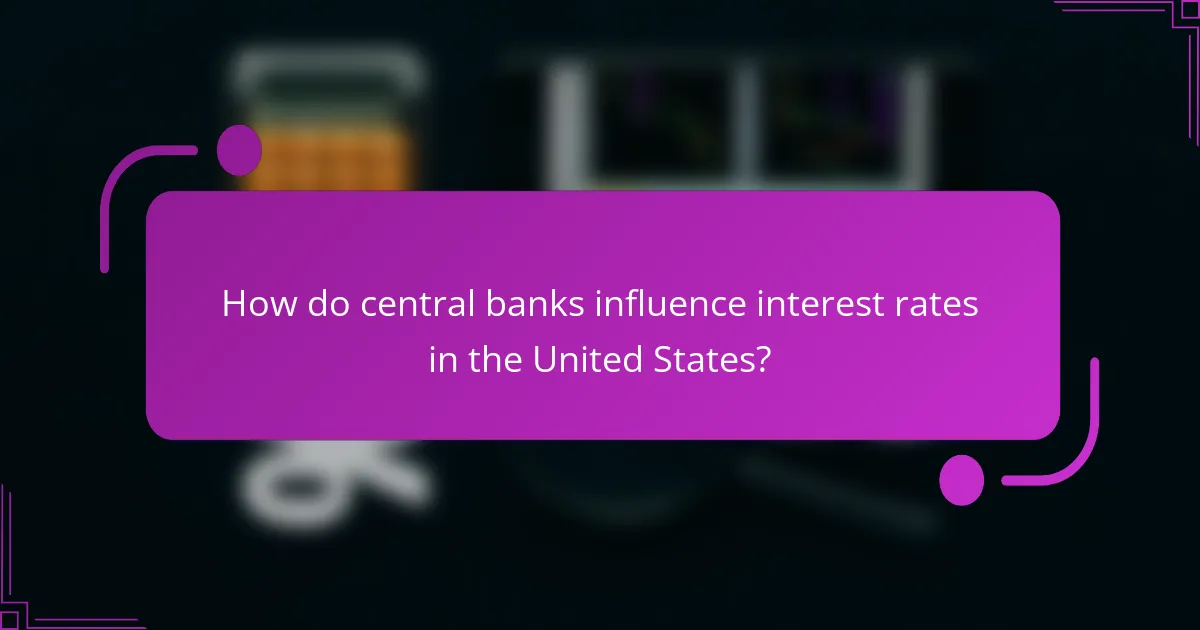Central banks play a crucial role in shaping interest rates through their monetary policy tools, which are essential for controlling inflation and stabilizing the economy. Changes in these rates directly impact consumers by affecting borrowing costs and savings returns, thereby influencing household budgets and spending behaviors.

How do central banks influence interest rates in the United States?
Central banks, particularly the Federal Reserve, influence interest rates in the United States primarily through monetary policy tools. These tools help control inflation and stabilize the economy by adjusting the cost of borrowing money.
Federal Reserve’s monetary policy
The Federal Reserve’s monetary policy is a framework used to manage economic stability and growth. It involves setting target interest rates, which directly affect consumer loans, mortgages, and savings rates. By raising or lowering these rates, the Fed can either encourage borrowing and spending or promote saving and investment.
For instance, during economic downturns, the Fed may lower interest rates to stimulate spending, while in times of rapid growth, it might increase rates to prevent inflation. This balancing act is crucial for maintaining a healthy economy.
Open market operations
Open market operations refer to the buying and selling of government securities by the Federal Reserve to influence the money supply. When the Fed buys securities, it injects money into the economy, lowering interest rates and encouraging lending. Conversely, selling securities withdraws money from circulation, which can raise interest rates.
This tool is one of the most commonly used methods for implementing monetary policy. For example, if the Fed aims to lower interest rates, it may purchase billions of dollars in Treasury bonds, which increases liquidity in the banking system.
Discount rate adjustments
The discount rate is the interest rate charged to commercial banks for borrowing funds from the Federal Reserve. Adjusting this rate influences how much banks are willing to lend to consumers and businesses. A lower discount rate makes borrowing cheaper for banks, which can lead to lower interest rates for consumers.
For example, if the Fed lowers the discount rate, banks may pass on these savings to borrowers, resulting in lower mortgage and loan rates. Conversely, raising the discount rate can tighten credit availability, making loans more expensive and potentially slowing economic growth.

What is the impact of interest rate changes on consumers?
Interest rate changes significantly affect consumers by influencing borrowing costs, savings returns, and overall financial behavior. When central banks adjust rates, it can lead to higher or lower payments on loans and credit, impacting household budgets and spending habits.
Effects on mortgage rates
Changes in interest rates directly affect mortgage rates, which can alter the cost of homeownership. For instance, when rates rise, monthly mortgage payments increase, making homes less affordable for many buyers. Conversely, lower rates can reduce payments, encouraging more people to enter the housing market.
Consumers should consider locking in a mortgage rate when rates are low to secure favorable terms. It’s also wise to shop around, as different lenders may offer varying rates based on market conditions.
Influence on credit card interest
Interest rate fluctuations can lead to changes in credit card interest rates, impacting how much consumers pay on outstanding balances. When rates increase, credit card interest rates typically follow suit, resulting in higher monthly payments for those carrying a balance.
To mitigate costs, consumers should aim to pay off credit card balances promptly and consider transferring balances to cards with lower interest rates. Monitoring promotional offers can also provide opportunities to save on interest payments.
Impact on savings accounts
Interest rates also influence the returns on savings accounts, with higher rates generally leading to better yields for savers. When central banks raise rates, consumers may earn more on their deposits, encouraging saving over spending.
However, many traditional savings accounts may not keep pace with inflation, so consumers should explore high-yield savings accounts or certificates of deposit (CDs) to maximize their returns. Regularly reviewing account options can help ensure that savings are working effectively for financial goals.

How do central banks respond to economic crises?
Central banks respond to economic crises primarily by implementing monetary policy tools aimed at stabilizing the economy. These responses often include quantitative easing, lowering interest rates, and establishing emergency lending programs to support financial institutions and stimulate economic activity.
Quantitative easing measures
Quantitative easing (QE) involves central banks purchasing government securities and other financial assets to inject liquidity into the economy. This process aims to lower interest rates and increase the money supply, encouraging lending and investment. For example, during the 2008 financial crisis, the U.S. Federal Reserve implemented QE to support economic recovery.
While QE can effectively stimulate growth, it may also lead to asset bubbles and increased inequality if the benefits are not widely distributed. Central banks must carefully monitor the outcomes to mitigate potential negative impacts.
Lowering interest rates
Lowering interest rates is a direct method for central banks to encourage borrowing and spending. By reducing the cost of loans, consumers and businesses are more likely to take on debt for purchases and investments. Typically, central banks might lower rates to near-zero levels during severe economic downturns.
However, prolonged low interest rates can discourage savings and may lead to excessive risk-taking in financial markets. It’s essential for central banks to balance the need for economic stimulus with the potential long-term consequences of low rates.
Emergency lending programs
Emergency lending programs provide financial support to banks and other institutions facing liquidity shortages during crises. These programs allow central banks to lend money at favorable terms, helping to stabilize the financial system. For instance, during the COVID-19 pandemic, various central banks introduced programs to support businesses and maintain credit flow.
While these programs can prevent systemic failures, they may also create moral hazard, where institutions take on excessive risk, believing they will be bailed out. Central banks must implement strict conditions to ensure responsible borrowing and lending practices.

What are the criteria for setting interest rates?
Central banks set interest rates based on several key criteria that influence economic stability and growth. These criteria include inflation targets, unemployment rates, and economic growth indicators, each playing a vital role in monetary policy decisions.
Inflation targets
Inflation targets are a primary criterion for setting interest rates, as central banks aim to maintain price stability within a specific range. Typically, a target inflation rate is set around 2% in many developed economies, which helps ensure that prices do not rise too quickly, preserving purchasing power.
When inflation exceeds the target, central banks may raise interest rates to cool down the economy and reduce spending. Conversely, if inflation is below the target, lowering interest rates can stimulate economic activity by encouraging borrowing and spending.
Unemployment rates
Unemployment rates significantly influence interest rate decisions, as central banks strive to achieve full employment. A high unemployment rate often prompts central banks to lower interest rates to stimulate job creation and economic activity.
For instance, if the unemployment rate is above 5%, a central bank may consider reducing rates to encourage businesses to invest and hire. However, if unemployment is low, raising rates may be necessary to prevent the economy from overheating.
Economic growth indicators
Economic growth indicators, such as GDP growth, consumer spending, and business investment, are crucial for setting interest rates. Central banks analyze these indicators to gauge the overall health of the economy and make informed decisions about monetary policy.
For example, if GDP growth is strong and consistently above 3%, a central bank might raise interest rates to prevent inflation from rising too quickly. In contrast, weak growth signals may lead to rate cuts to stimulate economic activity and support recovery.

How do international central banks compare in their influence on interest rates?
International central banks significantly influence interest rates through monetary policy tools, impacting economic activity and consumer behavior. Their decisions can lead to changes in borrowing costs, affecting everything from mortgages to business loans.
European Central Bank strategies
The European Central Bank (ECB) primarily uses interest rate adjustments and asset purchase programs to influence economic conditions across the Eurozone. By lowering rates, the ECB aims to stimulate spending and investment, while raising rates can help control inflation.
For instance, during economic downturns, the ECB may implement negative interest rates to encourage banks to lend more. This strategy has been employed in recent years to combat low inflation and stimulate growth in member countries.
Bank of England policies
The Bank of England (BoE) utilizes a similar approach to influence interest rates, focusing on the base rate to guide economic activity. Changes in the base rate directly affect consumer loans and mortgages, impacting household spending and business investments.
In recent years, the BoE has adjusted rates in response to economic conditions, such as Brexit uncertainties and the COVID-19 pandemic. For example, a reduction in the base rate can lower borrowing costs, encouraging consumers to spend and invest.
Bank of Japan approaches
The Bank of Japan (BoJ) employs unconventional monetary policies, including negative interest rates and quantitative easing, to combat deflation and stimulate economic growth. These strategies aim to increase liquidity in the economy and encourage lending.
For example, the BoJ’s negative interest rate policy means that banks must pay to hold reserves, incentivizing them to lend more to consumers and businesses. This approach has been critical in addressing Japan’s long-standing economic challenges.

What are the emerging trends in central banking?
Emerging trends in central banking include the increasing adoption of digital currencies, changes in monetary policy frameworks, and a greater focus on financial stability. These trends reflect the evolving economic landscape and the need for central banks to adapt to new technologies and challenges.
Digital currencies and interest rates
Digital currencies, particularly central bank digital currencies (CBDCs), are influencing interest rates by providing new tools for monetary policy. By enabling faster and more efficient transactions, CBDCs can help central banks implement interest rate changes more effectively.
The introduction of digital currencies may lead to lower transaction costs and increased competition among financial institutions, potentially impacting traditional interest rate structures. For example, if consumers can easily access digital wallets with lower fees, banks may need to adjust their interest rates to remain competitive.
Central banks are also considering how digital currencies could affect the money supply and inflation. As CBDCs gain traction, it will be crucial for policymakers to monitor their impact on overall economic stability and consumer behavior.



